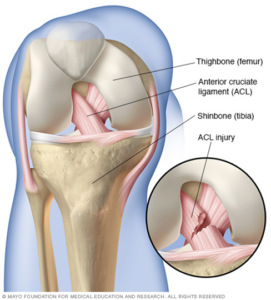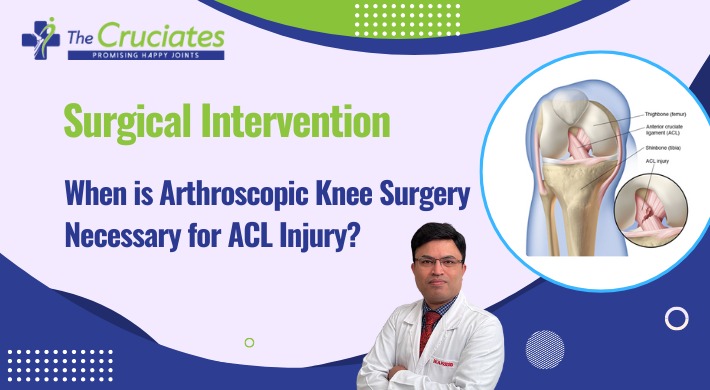Anterior cruciate ligament (ACL) injury is one of the most serious and painful injuries that can affect the knee joint. The instability caused by an ACL tear often requires surgical intervention in order to prevent further injury and restore full mobility. Arthroscopic knee surgery is a minimally invasive procedure used to diagnose and repair ACL tears, and is often the best course of treatment. In this blog post, we will discuss when arthroscopic knee surgery is necessary for ACL injury and how it can help patients regain strength and mobility.

Causes of ACL injury
The anterior cruciate ligament (ACL) is a crucial component of the knee joint that helps to provide stability and support during movement. Unfortunately, this ligament is susceptible to injury, especially during high-impact activities like sports and exercise. Some common causes of ACL injury include:
- Sports Injuries: ACL injuries are prevalent in high-intensity sports that involve quick changes in direction, jumping, and twisting movements, such as soccer, basketball, and football.
- Trauma: A direct hit or collision to the knee can cause an ACL injury, such as a car accident, fall, or workplace injury.
- Overuse: Overuse and repetitive movements can also lead to ACL injuries over time, particularly for athletes who engage in rigorous training regimens.
- Genetic Factors: In some cases, ACL injuries may be linked to genetic factors or conditions that affect joint health, such as osteoarthritis or hypermobility.
It’s important to note that not all ACL injuries are preventable, and even those who take necessary precautions can still suffer from an ACL injury. However, understanding the potential causes can help you take proactive steps to minimize your risk of injury.
Treating acute stage
An ACL injury is a traumatic experience that can be extremely painful and debilitating. Once the injury has occurred, the initial step is to manage the acute stage and reduce inflammation. This is the stage where pain and swelling are most pronounced and the knee is typically very unstable.
To reduce swelling and pain, apply ice packs to the affected area for 20 minutes every few hours. Compress the knee with an elastic bandage or brace, but make sure not to wrap it too tightly. Keep the knee elevated above the heart to encourage blood flow and reduce inflammation.
Non-steroidal anti-inflammatory drugs (NSAIDs) like ibuprofen and aspirin can also help to reduce pain and swelling. However, make sure to consult with your doctor before taking any medication, as some NSAIDs can interfere with the body’s natural healing process.
Depending on the severity of the injury, crutches may be necessary to help reduce pressure on the knee joint. It’s important to rest and avoid putting any weight on the affected knee during this stage.
In addition to these measures, it’s essential to seek professional medical advice to get an accurate diagnosis and treatment plan. Your doctor may recommend physiotherapy or suggest wearing a knee brace to help support the joint during the healing process.
In summary, treating the acute stage of an ACL injury requires immediate action to manage the symptoms and reduce inflammation. This involves using ice, compression, and elevation to minimize pain and swelling, taking appropriate medication, and avoiding any weight-bearing activity. Seek professional medical advice to get an accurate diagnosis and a suitable treatment plan to help recover quickly and safely.
When do you need surgery
Not all ACL injuries require surgery. In fact, many people can heal and recover from an ACL injury with non-surgical treatments like physical therapy and rehabilitation exercises. However, in some cases, surgery may be necessary.
Typically, surgery is recommended for people who are experiencing the following:
- Complete tear: If the ACL is completely torn, surgery is usually recommended.
- High activity levels: People who are highly active and participate in sports that require pivoting, jumping, or quick changes in direction may need surgery to ensure stability and strength in their knee.
- Chronic instability: People who experience chronic instability in their knee or recurrent injuries may need surgery to stabilize the joint.
- Difficulty with daily activities: If the injury is causing difficulty with daily activities, such as walking or climbing stairs, surgery may be necessary.
- Multiple ligament injuries: People who have injured multiple ligaments in their knee, in addition to the ACL, may require surgery to restore stability to the joint.
If surgery is recommended, the type of surgery will depend on the extent of the injury. In many cases, arthroscopic knee surgery is used to repair the torn ACL. This minimally invasive procedure involves inserting a tiny camera and surgical tools through small incisions in the knee to repair the ACL.
It’s important to note that surgery is not the only solution for ACL injuries. Your doctor will work with you to determine the best course of treatment based on the extent of your injury and your overall health and activity level.
Rehabilitation after surgery
After undergoing arthroscopic knee surgery for an ACL injury, it is important to engage in a comprehensive rehabilitation program to regain strength, flexibility, and stability in the affected knee. The success of the surgery and the overall outcome depend on adherence to a well-designed rehabilitation program.
The first phase of rehabilitation typically begins immediately after the surgery and may last up to four weeks. During this phase, the focus is on managing pain and inflammation, regaining mobility, and preventing complications such as blood clots. Physical therapy sessions may include gentle range-of-motion exercises, light muscle-strengthening activities, and low-impact cardiovascular exercises. The use of crutches or other assistive devices may be necessary during this phase.
The second phase of rehabilitation may start after four weeks and may last up to six months. During this phase, the focus shifts to building strength and stability in the knee, improving the range of motion, and reducing the risk of re-injury. Physical therapy sessions may include progressive strength training exercises, balance and coordination exercises, and functional movements such as squats and lunges. As the knee becomes stronger and more stable, more challenging exercises may be introduced.
The final phase of rehabilitation involves returning to normal activities, such as sports and daily tasks. The timing of returning to these activities varies depending on the individual and the specific type of surgery. A physical therapist or physician will work closely with the patient to establish a timeline for a safe return to activities. During this phase, ongoing physical therapy sessions may be needed to ensure that the knee is functioning optimally and that the patient has the confidence to engage in normal activities without fear of re-injury.
It is important to remember that rehabilitation after arthroscopic knee surgery for ACL injury is a process that takes time and commitment. With proper rehabilitation, patients can expect to regain their strength, flexibility, and mobility, and return to their normal activities with improved function and confidence.
“The Cruciates” is a team of highly experienced and skilled surgeons who are in the sports medicine field from a long time and have dealt with complicated sports injuries. Dr. Nagendra Prasad is one of the best ACL surgeon in Gurgaon leads the team. The Cruciates is committed to deliver high-quality services and would like to make sure that, you are satisfied with our work. The team Cruciates provides customized treatment and follow up to each patient to make sure that everyone will achieve desired level of recovery and rehabilitation to ensure early return to sports.

